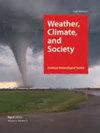情境风险和结果的解释-探索坦帕湾地区居民使用天气雷达显示
IF 1.9
4区 地球科学
Q3 ENVIRONMENTAL STUDIES
引用次数: 0
摘要
雷达显示器是一种描绘空间和时间气象数据的工具,因此,除了利用自己的气象知识和过去的天气经验外,个人还必须考虑空间和时间。我们旨在了解情景风险和结果的解释如何影响雷达显示的感知有用性,并探索雷达用户如何使用坦帕湾地区(佛罗里达州)的假设场景解释距离、时间和气象属性。最终,我们想了解个人如何以及为什么使用天气雷达,并发现是什么使它成为一个有用的工具。为此,本研究以解释水平理论和地理空间思维为指导,采用混合方法对四个研究目标进行了调查。我们的研究结果表明,我们的参与者最常使用雷达来预测他们所在地区不久的将来会发生什么。参与者用自己的话描述了他们在使用雷达显示器时看到的东西,并报告了他们预计在研究地点会有什么危险。许多参与者将闪电或强风的发生与雷达显示的“红色”和“橙色”反射率值联系起来。参与者就某些雷达显示的有用和无用之处提供了宝贵的见解。我们还发现,大多数参与者高估了他们在降水开始之前的时间。总的来说,天气雷达是一个非常有用的工具,然而,当风暴的运动/方向不容易识别时,判断空间和时间接近变得困难。本文章由计算机程序翻译,如有差异,请以英文原文为准。
Construal of Situational Risk and Outcomes – Exploring the Use of Weather Radar Displays with Residents of the Tampa Bay Region
A radar display is a tool that depicts meteorological data over space and time, therefore, an individual must think spatially and temporally in addition to drawing on their own meteorological knowledge and past weather experiences. We aimed to understand how the construal of situational risks and outcomes influences the perceived usefulness of a radar display and to explore how radar users interpret distance, time, and meteorological attributes using hypothetical scenarios in the Tampa Bay area (Florida). Ultimately, we wanted to understand how and why individuals use weather radar and to discover what makes it a useful tool. To do this, Construal Level Theory and geospatial thinking guided the mixed methods used in this study to investigate four research objectives. Our findings show that radar is used most often by our participants to anticipate what will happen in the near future in their area. Participants described in their own words what they were viewing while using a radar display and reported what hazards they expected at the study location. Many participants associated the occurrence of lightning or strong winds with ‘red’ and ‘orange’ reflectivity values on a radar display. Participants provided valuable insight about what was and wasn’t found useful about certain radar displays. We also found that most participants overestimated the amount of time they would have before precipitation would begin at their location. Overall, weather radar was found to be a very useful tool, however, judging spatial and temporal proximity became difficult when storm motion/direction was not easily identifiable.
求助全文
通过发布文献求助,成功后即可免费获取论文全文。
去求助
来源期刊

Weather Climate and Society
METEOROLOGY & ATMOSPHERIC SCIENCES-
CiteScore
3.40
自引率
13.60%
发文量
95
审稿时长
>12 weeks
期刊介绍:
Weather, Climate, and Society (WCAS) publishes research that encompasses economics, policy analysis, political science, history, and institutional, social, and behavioral scholarship relating to weather and climate, including climate change. Contributions must include original social science research, evidence-based analysis, and relevance to the interactions of weather and climate with society.
 求助内容:
求助内容: 应助结果提醒方式:
应助结果提醒方式:


